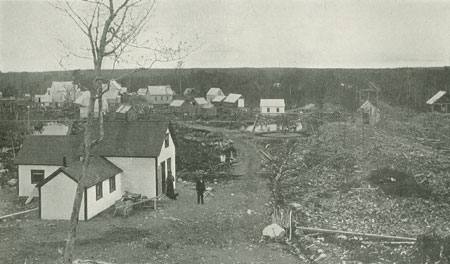Samuel D. Hudson discovered gold-bearing quartz boulders in the Forest Hill #Gold District in June 1893, and in June 1894, he and his brother discovered the Ophir lead.
Here's the story of the site!
#nspoli #cbpoli #novascotia #guysborough
@lloydphines @SeanFraserMP @modgcao

Here's the story of the site!
#nspoli #cbpoli #novascotia #guysborough
@lloydphines @SeanFraserMP @modgcao


Mining really began in Forest Hill, #Guysborough County, in 1895 and what had been only a wilderness was transformed by the end of 1896 into an active mining district with three mills, two or three stores, a schoolhouse, and a population of 200-300.
#nspoli #cbpoli #novascotia
#nspoli #cbpoli #novascotia

Some of the main veins mined at Forest Hill were the “Schoolhouse Veins,” undoubtedly located underneath the schoolhouse.
Mining operations were very active during the first 5 or 6 years of the district's history but then came a period of only intermittent activity until 1916.
Mining operations were very active during the first 5 or 6 years of the district's history but then came a period of only intermittent activity until 1916.

Total production from 1895-1916 was about 29,792 ounces of #gold, a fairly impressive figure given that mining took place only intermittently.
#nspoli #cbpoli #novascotia #guysborough
#nspoli #cbpoli #novascotia #guysborough

(Historical reporting of Forest Hill’s production was combined with that of several other #gold districts in the Country Harbour area, such as Stormont and Isaac Harbour, so Forest Hill’s production is estimated.)
#nspoli #cbpoli #novascotia #guysborough
#nspoli #cbpoli #novascotia #guysborough

In those early years the mining simply followed the visible #gold and was carried out by the sinking of vertical shafts or pits. The quartz was hand-cobbed and stamp mills were used to liberate the coarse gold from its host rock, along with gravity separation...
#nspoli
#nspoli

...and amalgamation using mercury. It’s been estimated that this process only recovered about 60% of the #gold in the ore, a reminder of how rudimentary gold mining was then compared to the sophisticated science it is now.
#nspoli #cbpoli #novascotia #guysborough
#nspoli #cbpoli #novascotia #guysborough

Nova Scotia #gold mines have not used mercury since the early 1900s because it’s bad for the environment.
After years of inactivity, mining started again in 1934 on the Schoolhouse Vein using a 10-stamp mill.
#nspoli #cbpoli #novascotia #guysborough
@SeanFraserMP @lloydphines
After years of inactivity, mining started again in 1934 on the Schoolhouse Vein using a 10-stamp mill.
#nspoli #cbpoli #novascotia #guysborough
@SeanFraserMP @lloydphines

Eventually, the Schoolhouse was worked to a depth of 103 metres. Several of the other shafts were also deepened and some work was done on the Ophir Vein.
Mining and exploration on various veins continued until 1956 when activity dropped off again.
#nspoli #novascotia #guysborough
Mining and exploration on various veins continued until 1956 when activity dropped off again.
#nspoli #novascotia #guysborough

Exploration started again in 1971 and has continued on and off since. In 1985-86, an exploration shaft was sunk to 230 metres below surface and a high grade zone of ore was mined by Seabright Resources on the newly discovered Adams Vein...
#nspoli #cbpoli #novascotia #guysborough
#nspoli #cbpoli #novascotia #guysborough

...named after Ken Adams, chief geologist on the project. Reports from this period indicate that #gold at Forest Hill occurs in very rich pockets called “jewelry boxes” by the miners.
#nspoli #cbpoli #novascotia #guysborough
#nspoli #cbpoli #novascotia #guysborough

In December 1985, Seabright purchased the former zinc-lead mine at Gay's River, #NovaScotia, from Esso Resources for $3.5 million (see our April 25 post about Gay’s River).
#nspoli #cbpoli #novascotia #guysborough
#nspoli #cbpoli #novascotia #guysborough

Seabright converted the mill to process #gold from its various properties including Forest Hill and Beaver Dam.
Seabright Resources was acquired by Western Mining Corporation of Australia in 1987 and its related company, Westminer Canada Limited, took over Forest Hill.
#nspoli
Seabright Resources was acquired by Western Mining Corporation of Australia in 1987 and its related company, Westminer Canada Limited, took over Forest Hill.
#nspoli

Westminer continued development at Forest Hill until 1989.
Exploration data from the Seabright/Westminer years suggests the site has significant potential to be a modern mine, like so many other historical Nova Scotia #gold mines.
#nspoli #cbpoli #novascotia #guysborough
Exploration data from the Seabright/Westminer years suggests the site has significant potential to be a modern mine, like so many other historical Nova Scotia #gold mines.
#nspoli #cbpoli #novascotia #guysborough

In fact, almost all the activity in #NovaScotia’s gold sector is at historical mines where deposits were proven during our early #gold rushes but modern science and technology make it possible to mine profitably while, of course, taking proper care of the environment.
#nspoli
#nspoli

• • •
Missing some Tweet in this thread? You can try to
force a refresh



























